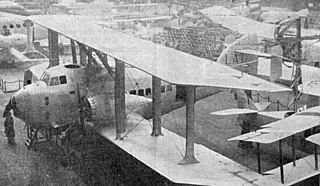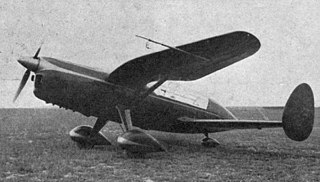Related Research Articles

The Utva-65 Privrednik (Merchant) is a Yugoslav civil aircraft designed and used for agricultural work.

The Latécoère 4 was a three-engined, 15-passenger biplane built in France in the early 1920s. It proved difficult to fly and was discontinued, though a second machine was completed as the Latécoère 5 bomber.

The Groppo XL and Groppo Trail are very similar single engine, tandem seat, high wing ultralight aircraft designed and built in Italy. Both can be supplied complete or in kit form. The two models differ chiefly in undercarriage type.

The CANSA FC.12 was a single engine monoplane ground attack aircraft developed in Italy around 1940. A crew of two were seated in tandem. Only ten production aircraft were built.
The Starck AS-37 is a two-seat biplane with unconventional wing and propulsion layouts. It was designed in France in the 1970s; though three were built and more than twenty sets of plans sold for home building, no AS-37s are active in 2012.
The MMPL Kanpur was an Indian light four-seat aircraft, designed for service and agricultural work in the early 1960s. It is a rare example of an aircraft designed and built by a national air force for its own use.
The Landray GL.01 is a small tandem-wing, side-by-side seat sport aircraft of the Mignet Pou-du-Ciel type. Built in the mid 1970s, the single example remains active.
The Landray GL.02 Ami Pou was a very basic, low-powered French tandem wing, single-seat sports aircraft. The only example flew in 1979.
The Landray GL.03 Pouss Pou was a small, pusher configuration tandem wing aircraft built in France in the early 1980s. Only one was completed, though it was much modified.
The Lebouder Autoplane was a French amateur built modular roadable aircraft, with a car-like component that could be separated from its aeronautical parts. The sole Autoplane flew and drove successfully in the early 1970s.

The Leduc RL.21 was a single engine, single seat light aircraft built in the late 1950s in France. Designed to achieve high speeds from modest engine power, it set seven class records in the early 1960s.
The Piel CP-40 Donald is a French homebuilt, single engine, single seat, high wing aircraft. It was first flown in the early 1950s, though the last of the three examples completed did not fly until almost forty years later.
The Pottier P.60 Minacro is a homebuilt French single seat biplane designed for aerobatics. It first flew in the early 1990s; about six have been completed.
The Caudron C.21 was a French twin engine biplane built just after World War I, able to carry three passengers in an open cockpit.

The Albessard Triavion, sometimes known as the Peyret-Albessard Triavion, was a three surface aircraft, combining a tandem wing and conventional tailplane.

The Delanne 20-T was a French tandem wing aircraft designed as an aerodynamic model for a larger fighter aircraft. It was tested during 1939.
The Leduc RL-12 was a French low power, economical, parasol wing, single seat aircraft. First flown in July 1939, its development was halted by World War II.

The Weymann-Lepère WEL-80 R.2 was a French two seat reconnaissance aircraft built to compete for a 1928 government contract. It was not successful and did not enter production.
The Kellner-Béchereau 23 was a French two seat cabin touring aircraft, built in 1932. Its wing was constructed in a novel way. Only one was completed.
The Laros-100 is a Russian light aircraft specifically designed for aerobatics flying.